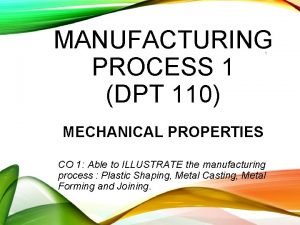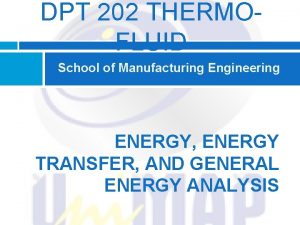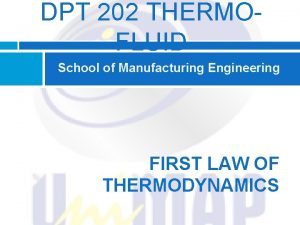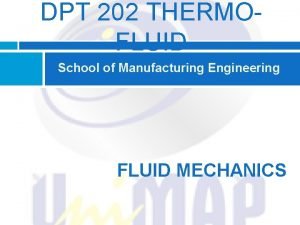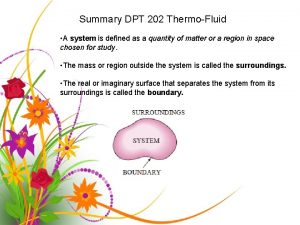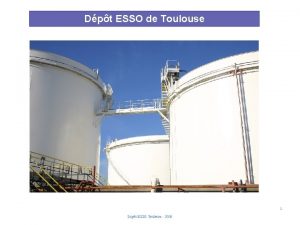DPT 202 THERMOFLUID School of Manufacturing Engineering INTRODUCTION











- Slides: 11

DPT 202 THERMOFLUID School of Manufacturing Engineering INTRODUCTION AND OVERVIEW

COURSE CONTENT & COURSE OUTCOMES COURSE CONTENT Chapter 1: Introduction and Overview Introduction of thermal-fluid sciences that categorized to thermodynamic, heat transfer, and fluid mechanics. Review the unit system and solving problem methodology. COURSE OUTCOMES CO 1: Ability to apply the basic principles of thermodynamics and analyse thermodynamic problem in a selected area of study. CO 2: Ability to apply the basic principles of heat transfer and analyse the heat transfer problem in a selected area of study. CO 3: Ability to apply the basic principles of fluid mechanic and analyse the fluid mechanic problem in a selected area of study. DPT 321 INJECTION MOLD DESIGN

Chapter 1: Introduction and Overview Self Reading Assignment: Topic Title Page No. 1 -1 Introduction to Thermal-Fluid Sciences 2 1 -2 Thermodynamics 4 1 -3 Heat Transfer 5 1 -4 Fluid Mechanics 6 1 -5 A Note on Dimensions and Units 7 1 -7 Problem Solving Technique 13

1. 1 - Introduction to Thermal-Fluid Science • The word thermal stems from the Greek word therme, which means heat. Therefore, thermal sciences can loosely be defined as the sciences that deal with heat. • Thermal-fluid sciences are usually studied under the subcategories of thermodynamics, heat transfer, and fluid mechanics • For example, designing the radiator of a car involves the determination of the amount of energy transfer from a knowledge of the properties of the coolant using thermodynamics, the determination of the size and shape of the inner tubes and the outer fins using heat transfer, and the determination of the size and type of the water pump using fluid mechanics. • Thermal-fluid sciences play a major part in the design and analysis of automotive engines, rockets, jet engines, and conventional or nuclear power plants, solar collectors, the transportation of water, crude oil, and natural gas, the water distribution systems in cities, and the design of vehicles from ordinary cars to airplanes

1. 2 - Thermodynamics • Thermodynamics can be defined as the science of energy. • The name thermodynamics stems from the Greek words therme (heat) and dynamis (power), which is most descriptive of the early efforts to convert heat into power. • One of the most fundamental laws of nature is the conservation of energy principle. It simply states that during an interaction, energy can change from one form to another but the total amount of energy remains constant. That is, energy cannot be created or destroyed. FIGURE 1 -1 Conservation of energy principle for the human body.

1. 3 - Heat Transfer • In heat transfer, we are primarily interested in heat, which is the form of energy that can be transferred from one system to another as a result of temperature difference. The science that deals with the determination of the rates of such energy transfers is heat transfer. • Thermodynamics is concerned with the amount of heat transfer whereas Heat Transfer is concerned with the rate of heat transfer. • The basic requirement for heat transfer is the presence of a temperature difference. There can be no net heat transfer between two mediums that are at the same temperature FIGURE 1– 2 Heat is transferred in the direction of decreasing temperature.

1. 4 - Fluid Mechanics • Fluid mechanics is defined as the science that deals with the behavior of fluids at rest (fluid statics) or in motion (fluid dynamics), and the interaction of fluids with solids or other fluids at the boundaries. Fluid mechanics is also referred to as fluid dynamics. • Fluid mechanics itself is also divided into several categories. The study of the motion of fluids that are practically incompressible (such as liquids, especially water) is usually referred to as hydrodynamics. • A subcategory of hydrodynamics is hydraulics, which deals with Incompressible liquid flows in pipes and open channels. • Gas dynamics deals with flow of fluids that undergo significant density changes, such as the flow of gases through nozzles at high speeds. • Aerodynamics deals with the flow of gases (especially air) over bodies such as aircraft, rockets, and automobiles at high or low speeds.

1. 5 - A Note on Dimension and Units • Any physical quantity can be characterized by dimensions. The arbitrary magnitudes assigned to the dimensions are called units. Dimensions: • Primary dimension or fundamental dimensions. (mass m, length L, time t, and temperature T) • Secondary dimensions or derived dimensions. (velocity , energy E, and volume V) Unit systems: • English System (inch (in), foot (ft) for length, oz, pound (lb) for mass, gallon (gal) for volume) • International System (meter (m) for length, kilogram (kg) for mass, second (s) for time)

1. 7 - Problem Solving Technique Step 1: Problem Statement Step 2: Schematic Step 3: Assumptions and Approximations Step 4: Physical Laws Step 5: Properties Step 6: Calculations Step 7: Reasoning, Verification, and Discussion

End of Chapter 1 Any Question?

Chapter 2: Basic Concepts of Thermodynamics Self Reading Assignment: Topic Title Page No. 2 -1 Closed and Open Systems 22 2 -2 Properties of a System 23 2 -4 State and Equilibrium 25 2 -5 Process and Cycles 26 2 -6 Temperature and the Zeroth Law of Thermodynamics 28 2 -7 Pressure 33 2 -8 Pressure Measurement Devices 37



